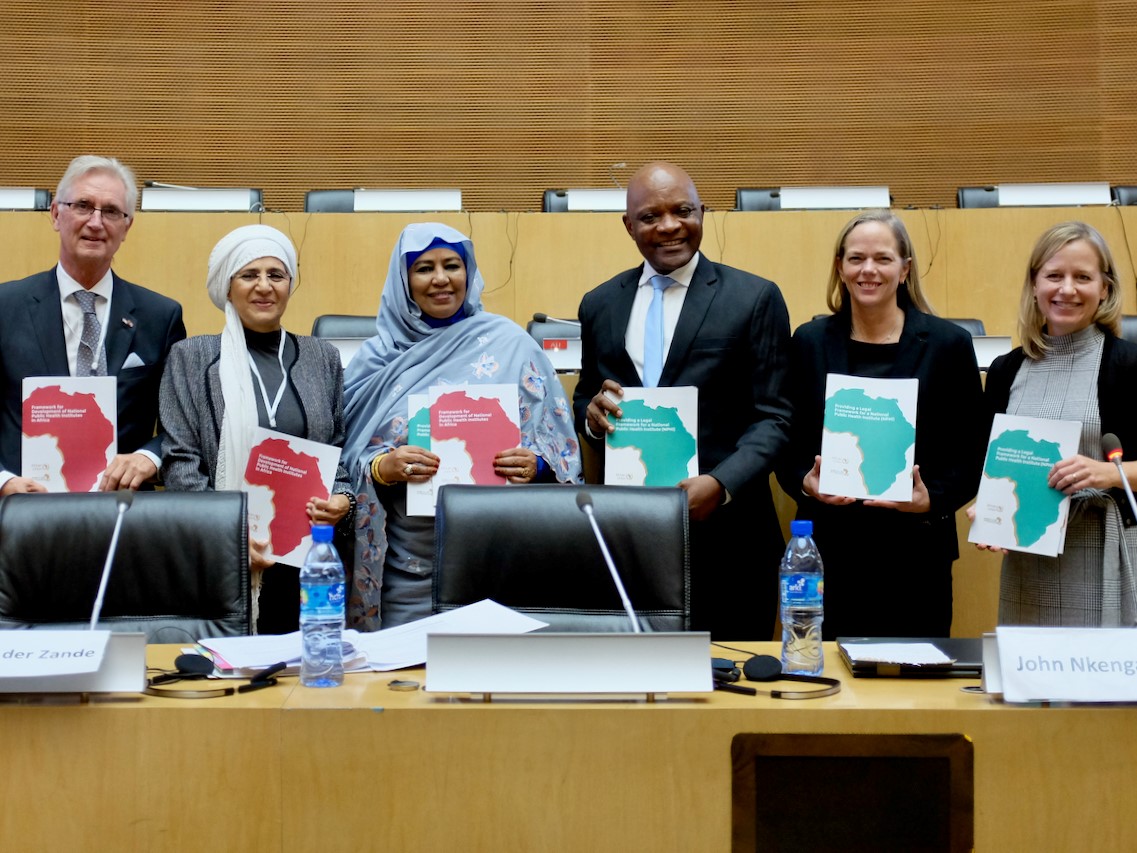U.S. CDC and IANPHI: a Partnership for Global Public Health
On June 14, 2021 the National Public Health Institute Program of the United States Centers for Disease Control and Prevention (U.S. CDC) celebrated its 10th anniversary. IANPHI has been working closely with CDC for years to support the strengthening of national public health institutes (NPHIs).

One of the successes of the IANPHI - U.S. CDC partnership has been the support to Africa CDC. From left to right: André van der Zande, former president of IANPHI; Natalie Mayet, deputy director of the National Institute for Communicable Disease in South Africa; Amira Elfadil, social affairs commissioner of the African Union; John Nkengasong, director of Africa CDC; Ellen Whitney, director of IANPHI U.S. Secretariat; and Shelly Bratton, lead of the U.S. CDC National Public Health Institute Program
A strong global public health infrastructure requires people, institutions and policies working in concert across disciplines, organizations and borders. Organizing public health expertise into NPHIs is a proven way for countries to bring together those often disparate elements. NPHIs strengthen public health infrastructure and protect people from disease and illness.
Since 2011, U.S. CDC and IANPHI have partnered to help build and bolster NPHIs in Latin America, Asia, Africa, and Europe. Strong NPHIs build public health capacity within a nation’s borders and foster collaboration beyond a nation’s borders to improve regional and global health security.
“IANPHI is the go-to organization for collaborating with NPHIs globally,” says Shelly Bratton, National Public Health Institute Program lead for U.S. CDC. “The collaboration is a two-way street. IANPHI helps U.S. CDC learn about other institutes’ priorities and needs, and at the same time helps us find effective ways of working with them.”
Founded in 2006, IANPHI is the only global alliance of public health leaders dedicated to strengthening and developing NPHIs. IANPHI and its members are building a global community of institutes whose scientific advisors work together to protect public health and promote equity.
U.S. CDC is a member of IANPHI and also maintains a platform for this strategic collaboration through an ongoing cooperative agreement between the two organizations that makes transformative investments to maximize other NPHIs’ self-reliance.
An example of this partnership (and an early success) was the effort in 2015 to help Zambian public health leaders reach their goal of establishing a national public health institute. IANPHI and U.S. CDC facilitated discussions and planning sessions among Zambian public health leaders and stakeholders, helping broker collective ambitions into an implementation roadmap. Just four years after that inaugural workshop, the Zambia National Public Health Institute (ZNPHI) was tapped to host the Southern Africa Regional Collaborating Centre (RCC) for Africa CDC, coordinating public health institutes across 10 countries, to help bridge Africa CDC’s support in the area before officially launching the RCC in 2021.
With strategic consultation from IANPHI, the U.S. CDC and others, Burkina Faso inaugurated its NPHI in 2018. The Institut National de Santé Publique (INSP) focuses on universal health coverage and houses both the nation’s health Emergency Operations Centers and the National Population Health Observatory. INSP also developed a five-year strategic plan with assistance from the partnership.
“Through this participatory and inclusive process, we were able to develop a roadmap not only for INSP, but for all actors involved in the implementation of essential public health services in Burkina Faso,” says Dr. Claude Millogo, an IANPHI consultant who has worked on public health in Burkina Faso for more than 20 years.
Assisting established NPHIs is also a pillar of the cooperative agreement. The Staged Development Tool (SDT) for National Public Health Institutes was created by U.S. CDC and IANPHI to help NPHIs assess and strengthen their technical and organizational competencies. U.S. CDC and IANPHI have created 30 SDT discussion guides for use by NPHIs. In 2018, IANPHI and U.S. CDC implemented a SDT facilitator training for 15 countries. The following year, U.S. CDC, IANPHI, and the World Health Organization Regional Office for Europe led an assessment of Ukraine Public Health Center’s functions to help identify areas for growth and improvement. NPHIs in Nigeria, Togo, Colombia, the United Kingdom, Ukraine, and Mongolia are among the 16 institutes that have completed SDT workshops.
Fostering peer-to-peer collaboration and training between member institutes is also a priority of the partnership. IANPHI’s peer-to-peer collaboration model facilitates sharing of expertise and experience between member NPHIs. Peer-to-peer collaboration offers recipient NPHIs and their staff an opportunity to learn from colleagues who are at a different stage in their development, identifying strategies for addressing priority needs, and raising performance standards. Contributing institutes also benefit from peer-to-peer collaboration as strong NPHIs bolster regional and global health.
In 2016, public health leaders from Malawi and Zambia sent delegations to Mozambique to study the operations of Mozambique’s more established public health institute. Similar peer-to-peer exchanges occurred in 2017 between Sierra Leone, Uganda and Mozambique. In 2019, a delegation from Burkina Faso visited public health institutes in Belgium and France.
With travel curtailed during the COVID-19 pandemic, peer-to-peer collaborations have shifted online. Under the umbrella of the cooperative agreement, IANPHI produces regular technical webinars bringing together members to share and discuss COVID-19 responses. Because the pandemic has surged in different locations at different times, public health experts who participate have been able to help each other anticipate pending challenges. In 2020, IANPHI created a communications working group to bring NPHI communications together for peer-to-peer discussions and skill-sharing. Currently, 35 member NPHIs participate.
“The COVID-19 webinars and digital working groups stand out as examples of how IANPHI can bring diverse organizations together,” says Bratton. “The pandemic is a unique challenge, but we know from prior health emergencies such as Zika, Lassa fever and Ebola that working together doesn’t just make institutes smarter and stronger. It makes the world safer.”